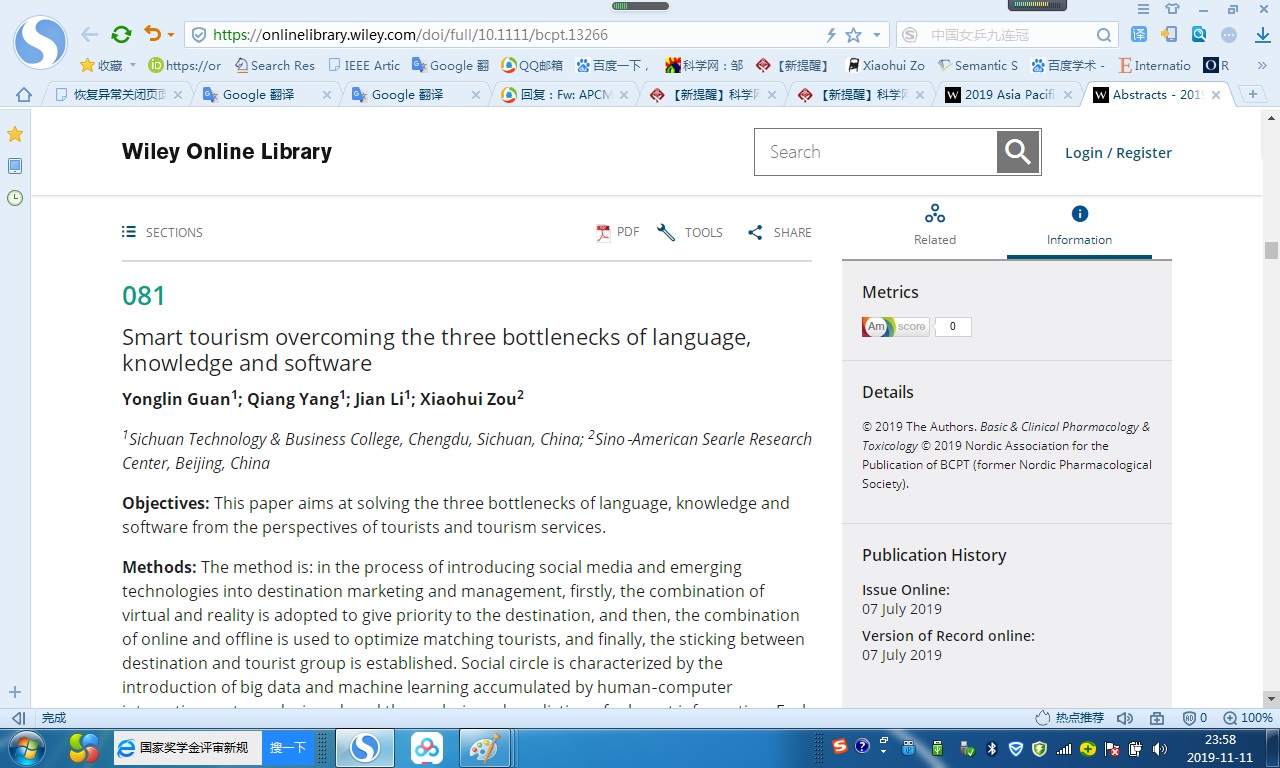博文
智慧旅游:克服语言、知识和软件的三个瓶颈
|||

Smart Tourism Overcoming the Three Bottlenecks of Language, Knowledge and Software
Yonglin Guan1; Qiang Yang1; Jian Li1; Xiaohui Zou2
1 Sichuan Technology & Business College, Chengdu, Sichuan, China
2 Sino-American Searle Research Center, Beijing, China
Objectives:This paper aims at solving the three bottlenecks of language, knowledge and software from the perspectives of tourists and tourism services.
Methods:The method is: in the process of introducing social media and emerging technologies into destination marketing and management, firstly, the combination of virtual and reality is adopted to give priority to the destination, then the combination of online and offline is used to optimize matching tourists, and finally, the sticking between destination and tourist group is established. Social circle is characterized by the introduction of big data and machine learning accumulated by human-computer interaction systems designed, and the analysis and prediction of relevant information. Each community or circle has its own unique brand leadership, order-driven or combination of the two, which is the focus of our attention and exploration. The GLPS, GKPS and GSPS are used to overcome the "three bottlenecks" and realize the three basic steps of Smart Tourism Information processing: Steps 1 is natural language understanding; Step 2: is expert knowledge acquisition); Step 3: is software pattern recognition. The characteristics are as follows: To implant the cultural concept, lifestyle and thinking habits of smart tourism into the concept consciousness of Sino-American tourists, ideal human-computer interaction systems are needed. Results:The expected results of this study are as follows: the sustainable development of characteristic tourism market at home and abroad can focus on tourism planning and blueprint description, characteristic tourism and its virtual experience, and in-depth tourism of various Sino-American tourists and their associations. Human-computer interaction system is its link.
Conclusions:The significance of this study lies in: firstly, the theory of cultural integration and its corresponding methods, which combine internationalization and localization accumulated by multinational corporations for a long time, are used for reference, optimized and transplanted to the organizations and individuals of smart tourism. This is undoubtedly an important thing. Then, the three bottlenecks of language, knowledge and software that smart tourism will inevitably encounter are put on the agenda as a key issue. This is undoubtedly another important thing. The specific advantages and examples are illustrated in the attached drawings.
Acknowledgements: This work was supported by Smart Tourism Research Laboratory in Sichuan Technology & Business College.
Correspondence Author: : Xiaohui Zou[ http://orcid.org/0000-0002-5577-8245 ] 949309225@qq.com
Published in Basic & Clinical Pharmacology & Toxicology in 2019
https://publons.com/publon/27524386/
081
Smart tourism overcoming the three bottlenecks of language, knowledge and software
Yonglin Guan1; Qiang Yang1; Jian Li1; Xiaohui Zou2
1Sichuan Technology & Business College, Chengdu, Sichuan, China; 2Sino‐American Searle Research Center, Beijing, China
Objectives: This paper aims at solving the three bottlenecks of language, knowledge and software from the perspectives of tourists and tourism services.
Methods: The method is: in the process of introducing social media and emerging technologies into destination marketing and management, firstly, the combination of virtual and reality is adopted to give priority to the destination, and then, the combination of online and offline is used to optimize matching tourists, and finally, the sticking between destination and tourist group is established. Social circle is characterized by the introduction of big data and machine learning accumulated by human‐computer interaction systems designed, and the analysis and prediction of relevant information. Each community or circle has its own unique brand leadership, order‐driven or combination of the two, which is the focus of our attention and exploration. The GLPS, GKPS and GSPS are used to overcome the “three bottlenecks” and realize the three basic steps of Smart Tourism Information processing: Steps 1 is natural language understanding; Step 2: is expert knowledge acquisition); Step 3: is software pattern recognition. The characteristics are as follows: To implant the cultural concept, lifestyle and thinking habits of smart tourism into the concept consciousness of Sino‐American tourists, ideal human‐computer interaction systems are needed.
Results: The expected results of this study are as follows: the sustainable development of characteristic tourism market at home and abroad can focus on tourism planning and blueprint description, characteristic tourism and its virtual experience, and in‐depth tourism of various Sino‐American tourists and their associations. Human‐computer interaction system is its link.
Conclusions: The significance of this study lies in: firstly, the theory of cultural integration and its corresponding methods, which combine internationalization and localization accumulated by multinational corporations for a long time, are used for reference, optimized and transplanted to the organizations and individuals of smart tourism. This is undoubtedly an important thing. Then, the three bottlenecks of language, knowledge and software that smart tourism will inevitably encounter are put on the agenda as a key issue. This is undoubtedly another important thing. The specific advantages and examples are illustrated in the attached drawings.
Acknowledgements: This work was supported by Smart Tourism Research Laboratory in Sichuan Technology & Business College.
Correspondence Author: Xiaohui Zou, Sino‐American Searle Research Center.

https://onlinelibrary.wiley.com/toc/17427843/125/S1
https://blog.sciencenet.cn/blog-94143-1205775.html
上一篇:医学工程与信息学跨学科知识中心建设方法
下一篇:科学实验结果要接受同行的重复实验检验